If you were born around 1950, you probably remember watching TV in black and white, swinging on a jungle gym, and playing house. Below, some of our finest cover artists illustrated what being a youngster was like in postwar America.
More Clothes to Clean
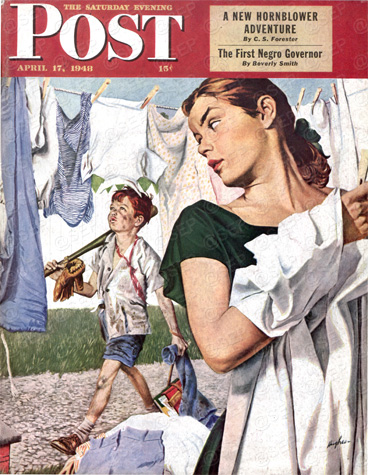
More Clothes to Clean
George Hughes
April 17, 1948
Although he was already a prominent illustrator by the late 1940s, George Hughes took his first crack at The Saturday Evening Post’s cover in 1948 (left)—and it was a smash hit right out of the ballpark! Reader response secured his position as one of the Post’s main illustrators alongside the likes of Norman Rockwell, John Falter, Stevan Dohanos, and Richard Sargent. “That copy arrived just as I have completed a washing much the same as pictured,” wrote one woman. “Only a blue-jeaned tomboy sister alongside junior is needed to get a complete story from my angle.”
Determined to be accurate, Hughes spent an entire day studying clothespins for the illustration. He knew if he didn’t get every detail right, there would be a barrage of letters to the editor telling him so. Employing a neighbor boy as the model, Hughes completed the painting. It was returned for a correction: “The editors asked me to ‘clean up the boy a bit, since he isn’t old enough to get that dirty.’ Actually, he was fully that dirty. But I pleased both the editors and his real mother by cleaning him up a little.” It was a fine line artists walked between pleasing, or at least not displeasing, Post readers and editors.
Good Guys Wear White Hats
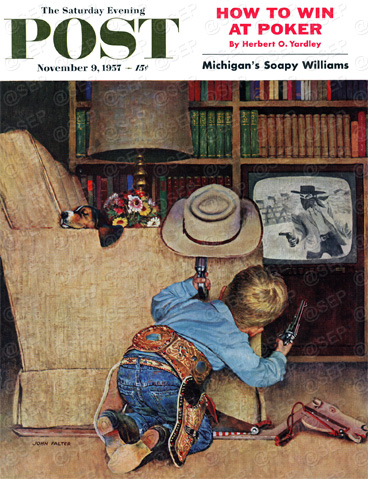
Good Guys Wear White Hats
John Falter
November 9, 1957
“Young Sammy Sixgun, using the classic hat-over-the-rock routine, will now restore law and order to the old TV-West,” wrote Post editors of this 1957 cover (left). Blissfully unaware of the drama unfolding around him is artist John Falter’s own dog, Ralph, snoozing on the couch.
John Falter (1910-1982) was born in Plattsmouth, Nebraska, and began sketching at the ripe old age of two—on a chalkboard his mother gave him. “His first commission came from a local soda shop that paid the budding artist in chocolate milk shakes for a well executed mural,” according to a 1991 article in the Post. He continued “to draw, sketch, and paint at an inspired pace for the rest of his life, completing, by his own estimate, more than 5,000 paintings.”
Playing House
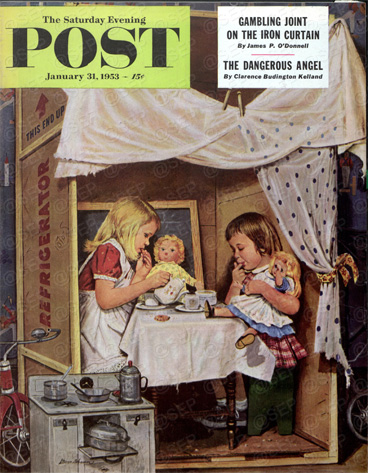
Playing House
Stevan Dohanos
January 31, 1953
This January 1953 cover (left) shows that Santa’s recent visit left some perfect items for playing house. Though contemporary Post editors saw them as lessons in “learning how to boil water without forgetting it and melting the pot down into the stove, and other complex principles of homemaking.” The editors noted, “The only uneducational toys in sight are the dolls, for they are not sniveling or hollering.”
Stevan Dohanos (1907-1994) was born in Lorain, Ohio, the son of Hungarian immigrants. His artistic career began, uniquely enough, in a steel mill. Employed as an office boy, Dohanos would copy the artwork he found on calendars and sell them to co-workers for 50 cents. Encouraged by family and friends, he took a two-year home study course and then went on to Cleveland Art School. His style is classified as American Realist, depicting the design and form of everyday objects like fire hydrants and milk bottles. He illustrated 123 Post covers between 1942 and 1958.
Hat Bridge
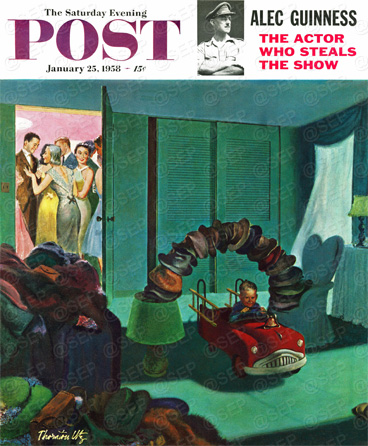
Hat Bridge
Thornton Utz
January 25, 1958
It’s difficult to say whether this young man at left will grow up to be a fireman or an engineer, for the precocious one structured what Post editors termed “an overpass” through which “he is lickety-tooting down a through way to a conflagration,” adding, “Heaven help that poor fedora in his path.” While giving the lad points for ingenuity, they couldn’t help but speculate what would come to pass when the guests come to sort out their property. “Those without a rollicking sense of humor,” they concluded, “may become a bit indignant—mad hatters, let’s call ’em.”
Like many artists, Thronton Utz (1914-2000) began his Post career illustrating short stories. His first cover came seven years later in 1949, and soon his art was known for its humorous twist on everyday life.
A Day in the Life of a Boy
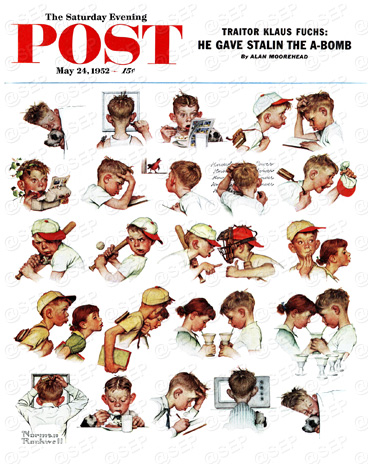
A Day in the Life of a Boy
Norman Rockwell
May 24, 1952
It’s a busy day for Charles Marsh Jr., the model for this cover: Get up; brush teeth; then, of course, there’s that bothersome school to deal with. Baseball and a charming lass provide diversions until it’s time to go home, do homework, and turn in.
Marsh modeled for Rockwell from the time he was a baby until he was 12 when Rockwell moved from Arlington, Vermont, to Stockbridge, Massachusetts. (Hear what it was like to work with America’s best-loved artist in “A Day in the Life of Norman Rockwell Model Chuck Marsh.”)
A good friend to him, Marsh considered the artist outgoing and community-minded. But no one knew just how community-minded until Rockwell donated the original painting A Day in the Life of a Boy to the Community Club for their annual raffle. Today, Rockwell’s Willie Gillis’ Package from Home, up for auction in Chicago, may fetch $3 to 5 million. But in the early 1950s, this particular painting went for a grand total of 50 cents.
A few months after the cover was published, there was a follow-up called A Day in the Life of a Girl, which featured Marsh in what he called “the toughest time I had posing”—because he was supposed to kiss the girl. For that story and other Rockwell kids of the ’50s, see “Rockwell in the 1950s–Part I of III.”
Jungle Gym
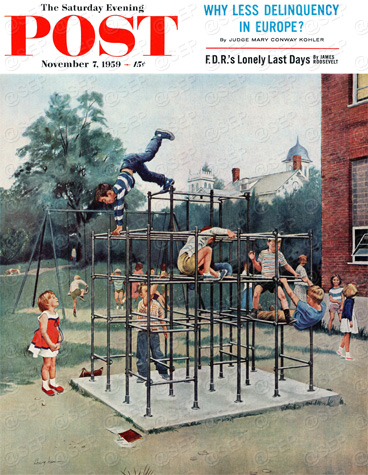
Jungle Gym
George Hughes
November 7, 1959
At left, the upside-down boy on top may look foolish to adult eyes, but he is King of the Jungle (gym) to the little blonde he is trying to impress. Once George Hughes became an established artist, he was able to move to Arlington, Vermont, and away from his native city, New York. He liked the idea of raising his children in a small community; he and his wife had five girls. There was the added bonus of being in an artists’ community, where he befriended Norman Rockwell and other Post artists.
Become a Saturday Evening Post member and enjoy unlimited access. Subscribe now
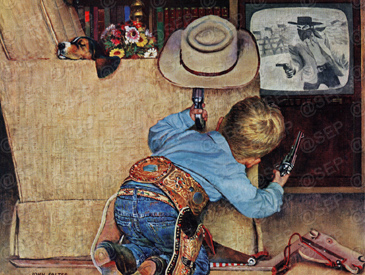

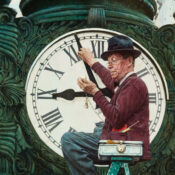
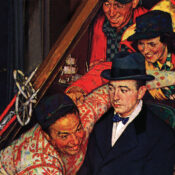
Comments
Actually, I was born in ’57, but DO remember watching TV in black & white, playing on the jungle gym, monkey bars, backyard pool slides and diving boards, all of which, sadly, have been law-suited out of existence, for some decades now. Not having a backyard pool my parents always made sure the places we stayed on vacation had the slides and boards for my younger sister and I to have a blast on. During the ’60s summers, Mom took us to a great public park pool nearby in our light lime green ’61 Falcon wagon. No slides but great boards–and a 12′ deep end. It’s fun feeling weightless!
Getting to the covers, my favorites are—all of them. Falter, Dohanos, Utz, Hughes and…Rockwell. My only question is how DID that tyke build that hat bridge? I’m not sure I would have been able to pull that one off–quite sure actually, but I must take my hat off to him. You go boy!
great pics. just missed being a baby boomer as I was born in 1942.
Diana always gets it right
hugs
Laura
I was born in 1942 so this is very relateable.
Diana always seems to pick out great stuff!
hugs
Laura
Thanks for the memories! It seemingly was such a slower, peaceful.
Children were allowed to be children. Having been born in 1943, I enjoy recalling those Good Old Days!